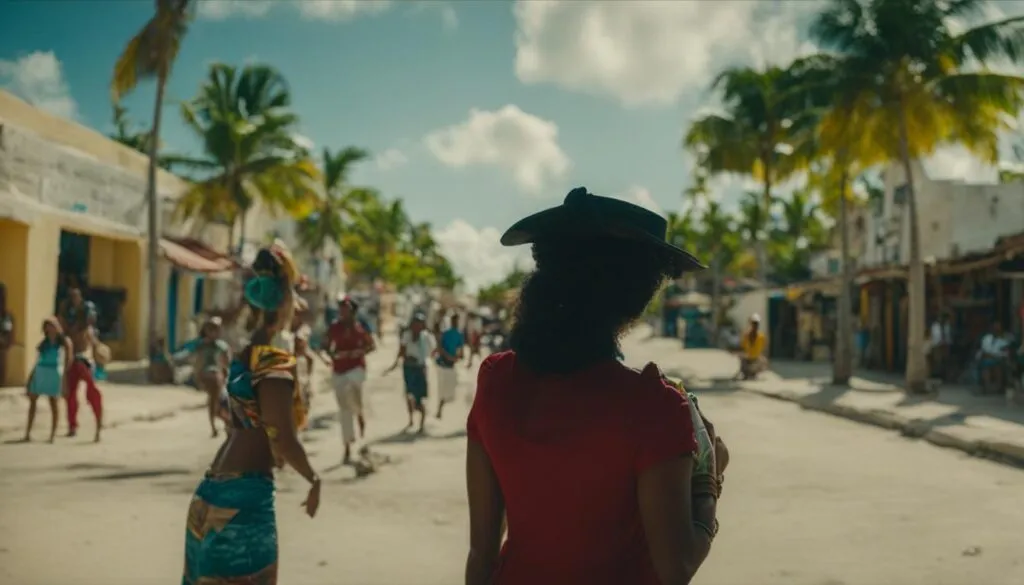If you’re planning a trip to Punta Cana in the Dominican Republic, it’s important to know what language is spoken in this popular tourist destination. The official language of Punta Cana, as well as the entire Dominican Republic, is Spanish. With over 85% of the population speaking Spanish, it is the primary language used in everyday communication.
However, Punta Cana’s linguistic landscape is diverse, reflecting the cultural influences and historical background of the region. In addition to Spanish, other languages are spoken by the locals, including Haitian Creole, Samaná English, and English. While Spanish remains predominant, understanding the other languages and dialects can enhance your travel experience and enable better communication with the locals.
Key Takeaways:
- Spanish is the official language of Punta Cana and the rest of the Dominican Republic.
- The local dialect of Spanish in Punta Cana may have some vocabulary and pronunciation differences.
- In addition to Spanish, other languages spoken in Punta Cana include Haitian Creole, Samaná English, and English.
- English is widely spoken in tourist areas, especially by hotel staff, tour guides, and restaurant employees.
- Learning some basic Spanish phrases can help you navigate daily interactions and foster cultural appreciation.
Spanish: The Official Language of Punta Cana
When traveling to Punta Cana, it’s essential to have an understanding of the official language spoken in the region. Spanish is the official language of Punta Cana and the Dominican Republic as a whole. Being able to communicate in Spanish will greatly enhance your experience and interactions with the locals.
Dominican Spanish, the local dialect spoken in Punta Cana, has some unique characteristics that differentiate it from other forms of the language. One notable feature is the dropping of the letter «s» in certain words. For example, instead of saying «gracias» (thank you), locals might say «gracia.» Another characteristic is the substitution of the letter «r» with «l.» So, «perro» (dog) may be pronounced as «pello.»
To further immerse yourself in the local language, you may encounter some old Spanish words no longer used in modern Spanish. Learning these words and phrases will impress the locals and demonstrate your respect for their culture.
| Spanish Words in Punta Cana | Meaning |
|---|---|
| Traba | Work |
| Jumo | Party |
| Guagua | Bus |
| Jeva | Girl |
| Juidera | Joke |
By familiarizing yourself with these unique aspects of Dominican Spanish, you’ll be able to communicate more effectively and connect with the locals in Punta Cana. So, don’t be afraid to practice your Spanish skills and embrace the rich linguistic diversity of the region.
Haitian Creole: A Minority Language in Punta Cana
Punta Cana not only encompasses the beauty of its pristine beaches but also embraces the linguistic diversity of its population. One such language spoken by a minority in Punta Cana is Haitian Creole. This unique language is primarily spoken by people of Haitian descent, who contribute to the cultural fabric of the region.
Haitian Creole originated as a fusion of French and African languages, resulting in a distinct linguistic identity. It is one of the two official languages of Haiti, reflecting the historical ties between the Dominican Republic and its neighboring country.
In Punta Cana, approximately 2% of the population, which equates to around 160,000 people, speaks Haitian Creole. Many of these speakers are bilingual, with Spanish being their second language. This linguistic diversity enriches the cultural heritage of Punta Cana, fostering a sense of inclusivity and appreciation for different linguistic backgrounds.

Preserving Linguistic Heritage
Haitian Creole serves as a reminder of the historical connections between the Dominican Republic and Haiti. As visitors explore Punta Cana, they may encounter elements of Haitian Creole in local conversations or cultural expressions.
Haitian Creole in Punta Cana represents the resilience and tenacity of the Haitian community, preserving their unique identity and contributing to the vibrant tapestry of Dominican culture.
By embracing the linguistic diversity of Punta Cana and promoting cultural understanding, travelers can gain a deeper appreciation for the rich tapestry of languages spoken in the region.
Samaná English: A Dialect in the Northeastern Part of Punta Cana
In the northeastern part of Punta Cana, particularly in the Samaná Peninsula, you’ll find a unique dialect of English known as Samaná English. This dialect is primarily spoken by descendants of black immigrants from the United States who settled in the area. While it is a variety of English, it is not widely spoken in Punta Cana and is not considered a major language in the region.
Samaná English is an intriguing linguistic blend that reflects the cultural heritage of those who speak it. With its roots in African American Vernacular English (AAVE) and other regional influences, this dialect has developed distinct features that set it apart from standard English.
Despite the rich history and cultural significance of Samaná English, it faces the threat of disappearance. There are currently only about 12,000 speakers of Samaná English remaining, making it a minority dialect within the Punta Cana region.
While Samaná English may not be widely understood or spoken by the general population, encountering this dialect during your visit to Punta Cana can offer a fascinating glimpse into the cultural diversity and historical connections of the local community.
«Samaná English is a testament to the cultural interchange and migration patterns that have shaped the region. It represents the linguistic heritage of an important group of people whose ancestors contributed to the development of Punta Cana and its surrounding areas.» – Local historian
While you may not encounter Samaná English in everyday conversations, taking the time to learn about this unique dialect can deepen your understanding and appreciation of the local culture during your visit to Punta Cana.
Continue reading to explore another language widely spoken in the tourist areas of Punta Cana: English.
English: Widely Spoken in Tourist Areas of Punta Cana
While English is not the primary language spoken in Punta Cana, it is widely spoken in tourist areas. Many locals working in the tourism industry, such as hotel staff, tour guides, and restaurant employees, have some knowledge of English to communicate with international visitors. However, the overall number of English speakers in Punta Cana is relatively small, accounting for less than 1% of the population. Travelers who are staying in resort zones or popular tourist destinations in Punta Cana will likely find English communication easier, but it’s still beneficial to learn some basic Spanish phrases for traveling around the country.
English, being a global language, plays a significant role in the tourism sector. Its widespread usage in Punta Cana caters to the needs of international travelers and ensures smoother interactions in tourist establishments. However, it’s important to note that while English may be more prevalent in these areas, learning and using some basic Spanish phrases can still enhance cultural immersion and create more meaningful connections with locals.
When communicating in English in Punta Cana, it’s essential to remember that not all locals are fluent in the language. Patience and understanding can go a long way in overcoming language barriers and fostering positive exchanges. A willingness to learn and respect the local language and customs can make your travel experience more enjoyable and enriching.

Language Diversity in the Dominican Republic
The Dominican Republic is a vibrant country that boasts a rich tapestry of languages spoken. While Spanish is the dominant language, there is a wide range of linguistic diversity present, reflecting the historical and cultural influences that have shaped the nation. In addition to Spanish, other languages commonly spoken in Punta Cana and throughout the country include Haitian Creole, Samaná English, and English.
Spanish, as the official language of the Dominican Republic, is widely understood and used in everyday communication. However, it’s important to note that the local dialect, known as Dominican Spanish, may have variations in vocabulary, pronunciation, and idiomatic expressions compared to standard Spanish.
Haitian Creole, originating from Haiti, is also prevalent in Punta Cana due to the significant population of Haitian immigrants and their descendants. This Creole language, a fusion of French and various African languages, is spoken by many Haitian communities throughout the country.
«With influences from Spain, Haiti, the United States, and other countries, the Dominican Republic is a melting pot of languages.»
Samaná English, a distinct dialect of English, is mainly spoken in the northeastern region of Punta Cana, particularly in the Samaná Peninsula. Its roots can be traced back to black immigrants from the United States who settled in the area. Although Samaná English has a small number of remaining speakers, it is a testament to the cultural diversity and historical connections between the Dominican Republic and the United States.
English, on the other hand, is widely spoken in tourist areas of Punta Cana, as it caters to the needs of international visitors. Many locals working in the tourism industry, such as hotel staff, tour guides, and restaurant employees, have a good command of English to assist and communicate with tourists.
Understanding and respecting the language diversity in Punta Cana can greatly enhance your travel experience. It not only allows for better communication with locals but also fosters cultural appreciation and connection. Learning a few basic phrases in Spanish or even acquainting yourself with key expressions in Haitian Creole or Samaná English can go a long way in building rapport and creating memorable experiences during your time in Punta Cana.
Language and Tourism in Punta Cana
In Punta Cana, as the most visited destination in the Caribbean, there is a strong correlation between language and tourism. The majority of tourists visiting Punta Cana come from English-speaking countries, such as the United States and Canada. As a result, many hotels, resorts, and tourist establishments in Punta Cana have English-speaking staff members and services to accommodate these visitors. However, it’s important to note that Spanish is still the primary language used by locals, and learning some basic Spanish phrases can enhance the travel experience and cultural interaction.
| Languages Spoken in Punta Cana | Percentage of Population |
|---|---|
| Spanish | 85% |
| English | Less than 1% |
| Haitian Creole | 2% |
| Samaná English | Under threat of disappearance |
While English is not the primary language spoken in Punta Cana, it is widely spoken in tourist areas. Many locals working in the tourism industry, such as hotel staff, tour guides, and restaurant employees, have some knowledge of English to communicate with international visitors. However, to fully immerse yourself in the local culture and connect with the people of Punta Cana, learning basic Spanish phrases is highly recommended.
«Being able to communicate in the local language allows you to engage with the locals on a deeper level and gain a greater understanding of their culture and way of life.»
Benefits of Learning Basic Spanish
- Enhanced cultural interaction
- Improved ability to navigate daily interactions
- Increased appreciation for local customs and traditions
- Opportunity to connect with the local community
By making the effort to learn some basic Spanish phrases, you can show respect for the local language and culture, and enhance your overall travel experience in Punta Cana.
Cultural Etiquette and Language in Punta Cana
When visiting Punta Cana, it’s important to be culturally sensitive and respectful of the local language and customs. While many locals may have some knowledge of English, attempting to communicate in Spanish, even with basic phrases, can go a long way in building rapport and showing appreciation for the local culture.
Locals in Punta Cana are generally friendly and helpful, and making an effort to speak their language can further enhance the travel experience and create positive connections. By using phrases like «Hola» (hello), «Por favor» (please), and «Gracias» (thank you), you can easily engage with locals and make them feel respected.
«The ability to communicate with locals in their language shows a genuine interest in their culture and establishes a stronger connection.» – Traveler’s comment
Learning a few common phrases can also help navigate everyday situations, such as ordering food, asking for directions, or shopping at local markets. This small effort can make a big difference in how locals perceive you as a traveler.
Additionally, understanding cultural norms and customs can help you avoid unintentional misunderstandings. For example, it’s considered polite to greet people with a handshake and maintain eye contact during conversations. Respect personal space and be mindful of cultural differences when interacting with locals.
By immersing yourself in the local culture and language, you’ll have a richer and more authentic experience in Punta Cana. Remember, it’s not about fluency, but rather the effort and respect you show towards the locals and their traditions.
Etiquette Tips for Interacting with Locals in Punta Cana:
- Learn basic Spanish phrases and use them when engaging with locals.
- Greet people with a handshake and maintain eye contact.
- Show respect for personal space and cultural differences.
- Ask for permission before taking photos of people.
- Be patient and understanding, especially when faced with language barriers.
By following these cultural etiquette tips and making an effort to communicate in the local language, you’ll be able to connect with the warm and welcoming people of Punta Cana on a deeper level, creating lasting memories of your trip.
Conclusion
In conclusion, Spanish is the primary language spoken in Punta Cana, the popular tourist destination in the Dominican Republic. The majority of the local population is fluent in Spanish, and it serves as the official language of the country. However, Punta Cana is a linguistically diverse region, with other languages spoken as well.
Among these languages is Haitian Creole, which is spoken by members of the Haitian community in Punta Cana. Additionally, Samaná English, a dialect of English, is spoken in the northeastern part of the region, particularly in the Samaná Peninsula. English itself is widely spoken in tourist areas of Punta Cana, catering to the needs of international visitors.
Understanding and respecting the language diversity in Punta Cana can greatly enhance your travel experience. While many locals may have some knowledge of English, making an effort to speak basic Spanish phrases can help you better connect with the local community. Learning a few common Spanish expressions can go a long way in navigating daily interactions and immersing yourself in the local culture, ultimately making your visit to Punta Cana more enjoyable.
FAQ
What language do they speak in Punta Cana?
The primary language spoken in Punta Cana is Spanish, as it is the official language of the Dominican Republic. However, there are also other languages spoken in Punta Cana, including Haitian Creole, Samaná English, and English.
Is Spanish the official language of Punta Cana?
Yes, Spanish is the official language of the Dominican Republic, including Punta Cana.
Are there any dialects of Spanish spoken in Punta Cana?
Yes, Punta Cana has its own local dialect of Spanish, known as Dominican Spanish. This dialect has some unique vocabulary and pronunciation differences compared to other forms of Spanish.
What is Haitian Creole, and is it spoken in Punta Cana?
Haitian Creole is a minority language spoken in Punta Cana, primarily by people of Haitian descent. It is one of the official languages of Haiti and is based on French mixed with African languages.
Is Samaná English widely spoken in Punta Cana?
Samaná English is a dialect of English spoken in the northeastern part of Punta Cana, particularly in the Samaná Peninsula. However, it is not widely spoken and is considered a minority language in the region.
How widely is English spoken in Punta Cana?
While not the primary language, English is widely spoken in tourist areas of Punta Cana. Many locals working in the tourism industry have some knowledge of English to communicate with international visitors.
Are there any other languages spoken in Punta Cana?
Apart from Spanish, Haitian Creole, Samaná English, and English, there are no major languages spoken in Punta Cana. However, due to the diverse nature of the country, there may be individuals who speak other languages.
What should I do to communicate effectively in Punta Cana?
While English is spoken in tourist areas, it is beneficial to learn some basic Spanish phrases for travel in Punta Cana. This can enhance communication and cultural interaction with the locals.
How can I be culturally sensitive when it comes to language in Punta Cana?
It is important to respect and appreciate the language diversity in Punta Cana. Attempting to communicate in Spanish, even with basic phrases, shows your interest in the local culture and can help build positive connections with the locals.
What is the primary language spoken by locals in Punta Cana?
The primary language spoken by locals in Punta Cana is Spanish.







